It is also called e-paper. Electronic ink or e-ink is a display technology using organic electronics designed to mimic the appearance of regular ink on paper. Reflects light like ordinary paper. Can be maintained without a constant supply of power.
CONSTRUCTION OF E-PAPER
It has two different parts:
- Front plane
- Backplane.
When a positive or negative electric field is applied, corresponding particles move to the top of the microcapsule where they become visible to the viewer. This makes the surface appear white or black at that spot.
TECHNOLOGIES PROPOSED SO FAR
- Gyricon
- Electrophoretic display
- Electrowetting
- Electrofluidic display
- Interferometric modulator (Mirasol)
GYRICON
It was developed in the 1970s. Consists of polyethylene spheres having a diameter between 75-106 micrometers. Gyricon is spherical beads with one black and one white hemisphere. The spheres are only 100um in diameter and make a display that is only 200um thick. In the display, the beads are dispersed in a transparent rubber sheet and suspended in oil, allowing them to rotate in response to an electric field. For one polarity, the white hemisphere faces the viewing direction. Reversing the field polarity will cause the black sphere to be seen. The orientation of the beads stays the same even after the field is removed, allowing images to be stored. Also, no backlight is needed to view an image on the rubber sheet.
The display consumes energy only when forming an image and even this is very low power. The Gyricon rubber sheet is thin, robust, and highly flexible. It can be made in large sheets or cut by designers to fit the application. The optical properties of the Gyricon are similar to those of paper, making it attractive for future display applications such as book and newspaper readers.
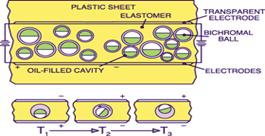
ELECTROPHORETIC DISPLAY
Relies on electrostatic migration of light-scattering particles in a dyed colloidal suspension. When a positive voltage is applied, the particles migrate electrostatically toward the electrode on the viewer side. A near-Lambertian reflection can be obtained using white light scattering particles. When a negative voltage is applied, the particles move to the electrode on the side away from the viewer and become hidden behind the dye; the viewer sees the color of the dye. Creates a bistable memory device when voltage is removed.
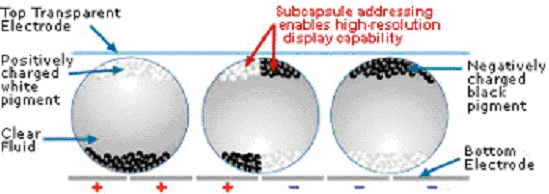
ELECTROWETTING DISPLAY
It is based on the phenomenon of the Electrowetting effect. With no voltage applied, the (colored) oil forms a flat film between the water and a hydrophobic (water-repellent) insulating coating of an electrode, resulting in a colored pixel. When a voltage is applied between the electrode and the water, the interfacial tension between the water and the coating changes. As a result, the stacked state is no longer stable, causing the water to move the oil aside. This results in a partly transparent pixel, or if a reflective white surface is used under the switchable element, a white pixel.
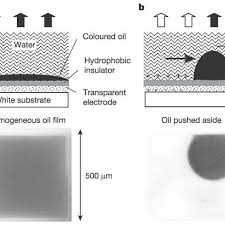
ELECTROFLUIDIC DISPLAYS
It is a variation of an electrowetting display. Consists of aqueous pigment dispersion inside a tiny reservoir. The reservoir comprises <5-10% of the viewable pixel area and therefore the pigment is substantially hidden from view. Voltage is used to electromechanically pull the pigment out of the reservoir.
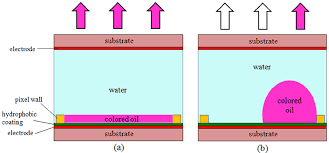
INTERFEROMETRIC MODULATOR(Mirasol)
The technology used in electronic visual displays can create various colors via interference of reflected light. The color is selected with an electrically switched light modulator comprising a microscopic cavity that is switched on and off using driver integrated circuits similar to those used to address liquid crystal displays (LCD).
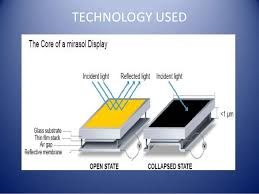
FUNCTIONALITY
The new paper phone is made of two layers: the e-ink display and a flexible printed circuit with bend sensors. Flexible printed circuit with resistive bend circuits, which are used to identify the bending of the display screen. The user chooses the function by bending the PCB.
For example, you can choose to bend the upper-right corner to make a call or bend the lower left to listen to music.
We have software that collects the values given by the bend sensors. These gestures are then fed into a gesture-recognition engine trained to associate certain movements with certain instructions.
For example: bending the bottom corner of the display down will move one contact down when navigating through a contact list
| E-PAPER | LCD |
|---|---|
| Electronic Ink Display | Liquid Crystal Display |
| Wide viewing angle | Best image only from one position |
| Readable in sunlight | Can be difficult to see in sunlight |
| Holds image without power drain | Require power to hold images |
| Plastic or glass | Glass only |
| Light Weight | Power supply and glass make LCDs relatively heavy |
| Thin (~ 1 mm) | Thick (~7 mm) |
ADVANTAGES
- Consumes significantly less energy.
- Able to display true black picture
- Wider viewing angles.
- Thinner display.
- Better contrast ratio.
- Safer for the environment.
- Has the potential to be mass-produced inexpensively.
- Once a display is written it will stay displayed even when power is switched off.
- Due to the use of e-paper the trees are saved.
DISADVANTAGES
- Constraints with life span.
- Easily damaged by water.
- Limited market availability.
- Very low switching speed.
- Electrochemical complexity.
- Slow response to change.
- Too slow for video.
- A shadow of an image may be visible after refreshing parts of the screen. Such shadows are termed “ghost images”, and the effect is termed “ghosting”.
APPLICATIONS
- Lighting.
- Flexible / bendable lighting.
- Wallpaper lighting defining new ways to light a space.
- Transparent lighting doubles as a window.
- Cell Phones.
- E-paper readers may soon replace the present newspaper and books.
- Transparent Car Navigation System on Windshield.
- Using Samsung’s transparent OLED technology
- Heads up display
- GPS
FUTURE SCOPE
- More advanced wireless capabilities.
- E-paper readers may soon replace the present newspaper and books. In the future, we can see the direct video paper.
- Scroll Laptop
- With the developments in flexible display, we are able to make scroll laptops. This makes portability reliable. requires only less space.
- Electronic shelf labels in Grocery stores- cuts out time it takes for Workers to change labels for specials or new items.
- No Knob Etch-a-sketches- children draw with electronic ink then erase with the push of a button.
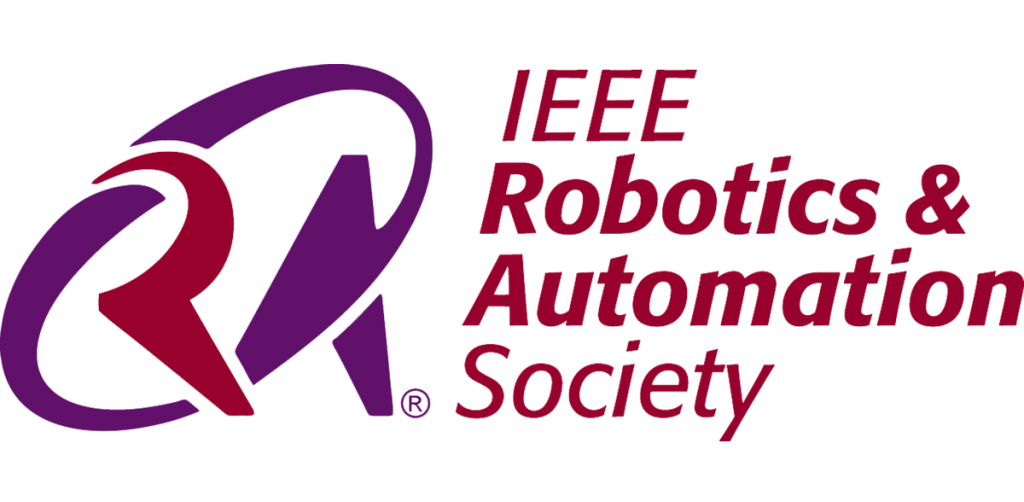
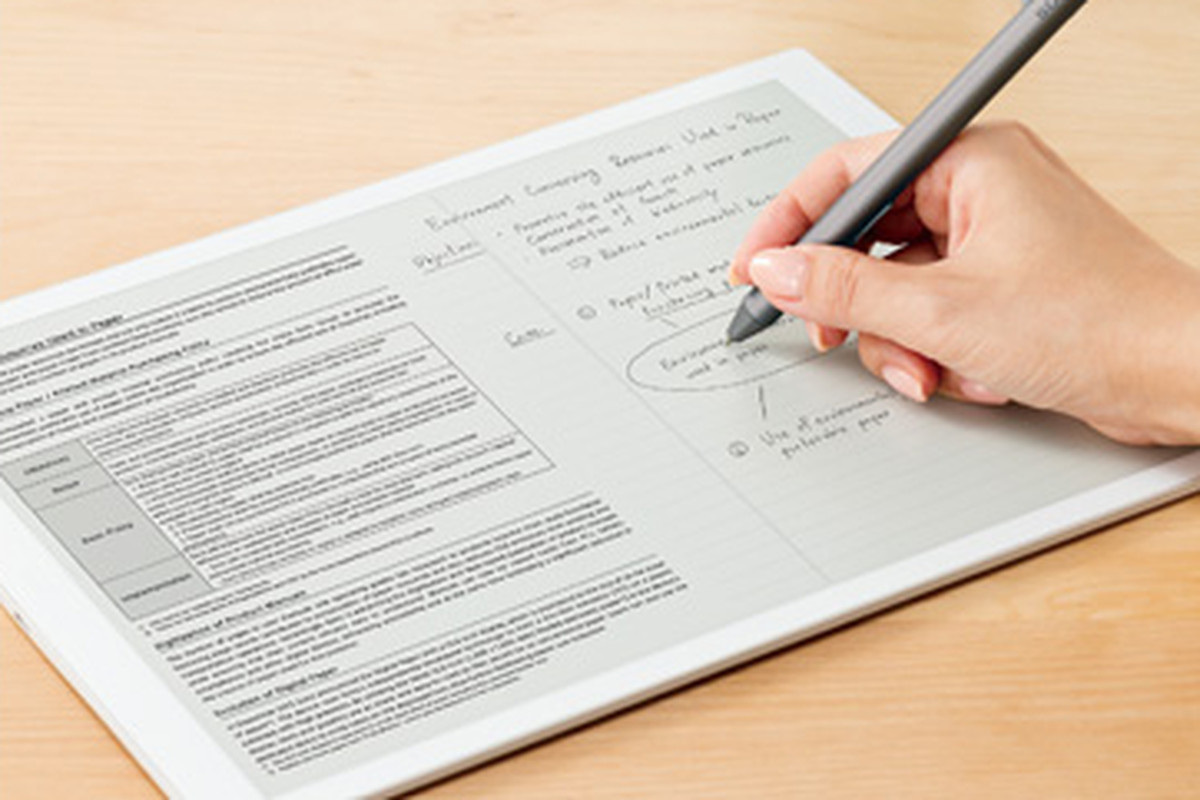

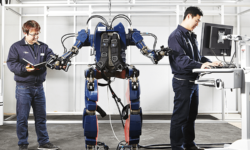

Wow, incredible blog layout! How long have you been blogging for?
you made blogging look easy. The overall look of your website is magnificent, as well as the content!